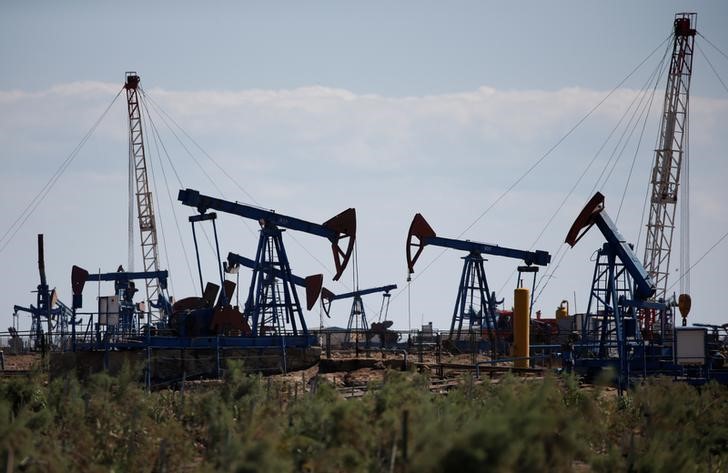 © Reuters. Pump jacks pump oil at an oil field on the shores of the Caspian Sea in Baku
© Reuters. Pump jacks pump oil at an oil field on the shores of the Caspian Sea in BakuBy Devika Krishna Kumar
NEW YORK (Reuters) – Oil prices jumped about 2 percent on Friday, with global benchmark Brent crude rising above $60 per barrel, on support among the world’s top producers for extending a deal to rein in output and as the dollar retreated from three-month peaks.
Ahead of OPEC’s policy meeting on Nov. 30, Saudi Arabia and Russia declared their support for extending an OPEC-led deal to cut supplies for another nine months, the Organization of the Petroleum Exporting Countries’ secretary general said. The pact currently runs to March 2018.
Brent futures () rose $1.05, or 1.8 percent to $60.35 a barrel by 11:56 a.m. ET (1556 GMT), after rising to a session high of $60.53, the highest since July 2015 and more than 35 percent above its 2017 lows touched in June.
U.S. West Texas Intermediate crude oil (WTI) () was up $1.11, or 2.1 percent at $53.75 after rising to a session high of $53.93 a barrel, the highest since early March.
For the week, Brent was 4.5 percent higher, on track for its third straight weekly gain. U.S. crude, meanwhile, was set for a 4.4 percent rise for the week, capped by rising domestic production.
Oil prices have been hovering near their highest levels for this year amid signs of a tightening market, renewed support this week of an extension of production cuts and tensions in Iraq.
However, Friday’s announcement of a ceasefire between Iraqi forces and the Peshmerga from the country’s autonomous northern Kurdish region eased some concerns.
“What is interesting is that the pop in WTI futures moved above the Sept. 28 high,” said David Thompson, executive vice president at Powerhouse, an energy-specialized commodities broker in Washington, D.C.
“So even though the dollar is giving back some of its move, crude may now be trading off of a new driver, the technical breakthrough to a new high.”
The dollar trimmed its earlier gains versus a basket of currencies () following a Bloomberg report that U.S. President Donald Trump is said to be leaning toward Federal Reserve Governor Jerome Powell as his pick to head the U.S. central bank.
A weaker dollar makes greenback-denominated commodities, including oil, cheaper for holders of other currencies.
“I think the combination of short covering and Chevron (NYSE:) and Exxon (NYSE:) both missing their production guidance for the third quarter has resulted in the market strength today,” said Scott Shelton, energy futures broker with ICAP (LON:) in Durham, North Carolina.
TransCanada Corp (TO:) said in a filing on Thursday that it is seeking to raise the temporary discounted spot rate for light crude on its 700,000 barrel-per-day Marketlink pipeline. The news sent WTI’s discount to global marker Brent
OPEC and other major producers including Russia have pledged to reduce production by around 1.8 million barrels per day (bpd) to drain a global supply glut.
“If OPEC and their non-OPEC partners can agree to extend their production curtailments through 2018, then we estimate the oil market will remain in modest under-supply until 2019,” U.S. Investment bank Jefferies said.
Rising U.S. crude production remains an issue for OPEC as it strives to clear a global overhang.
Government data showed that U.S. crude production rose 1.1 million bpd last week to 9.5 million bpd after a decline due to Hurricane Nate, while U.S. oil exports hit a new record four-week average of 1.7 million bpd. [EIA/S]
However, U.S. drillers have cut rigs since August. Data on the U.S. rig count, an early indicator of future output, was due at 1 p.m..
Source: Investing.com



























